Gravity Of Soil Solids
Pycnometer Method 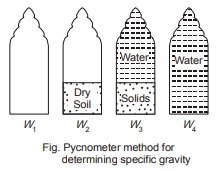
- This method is similar to Pycnometer method for water content determination, but here oven dry soil is taken instead of moist soil.
Let, W1 = Weight of empty pycnometer
W2 = Weight of pycnometer + soil sample (oven dry)
W3 = Weight of pycnometer + soil solids + water
W4 = Weight of pycnometer + waterWeight of solid, Ws = W2 – W1
= (W4 – W1) – (W3 – W2 ) = [W2 – W1] – [W3– W4]∴ Gs = Weight of solid (Ws) / Weight of equivalent volume of water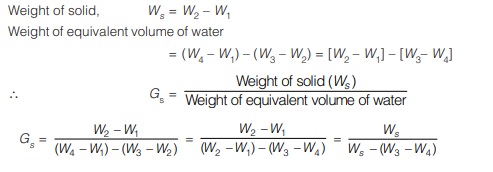
where, Ws = Weight of solids (or dry weight of soil)
Core Cutter Method
- This method is used in the case of cohesive soil.
- This method cannot be used in case of hard and gravelly soils.
- Core-cutter is a cylindrical vessel with open at top and bottom with sharp edges usually having 10 cm dia and 12.5 cm height with volume nearly 1000 cc.
- The soil surface is prepared and levelled in field and cylindrical core-cutter is punched into ground and cylinder filled with soil is taken out, which is levelled at top and bottom.
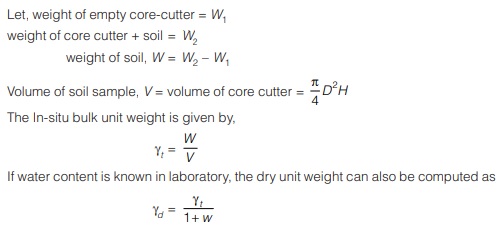
Sand Replacement Method
- This is a field method.
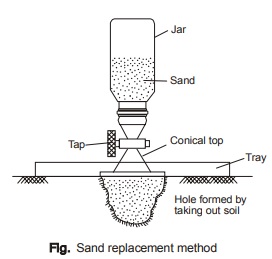
- This method is used in case of hard and gravelly soils where core-cutter method can not be used.
- In this method, a small pit or hole is made in the ground. The excavated soil is collected in the tray and weighed, say W. Now the pit is filled with sand which is measured through calibrated cylinder. Volume of soil, V = volume of sand required to fill the pit completely.
- In-situ unit weight is obtained by dividing weight of excavated soil with volume of hole.
γ = W/V - The water content of the excavated soil is also determined and the dry unit weight is obtained by using
γd = γ / 1 + w - This method is widely adopted in construction of highways.
Grain Size Distribution
- Grain size analysis of coarse grained soils is carried out by sieve analysis, whereas analysis of fine grained soils is by sedimentation method i.e. either by hydrometer or pipette method.
- Generally, most of the soil contains both coarse as well as fine grain constituents. Hence a combined analysis is usually carried out
- In combined analysis, dry soil fraction retained on sieve size 4.75 mm is called gravel fraction which is subjected to coarse sieve analysis and soil fraction passing through 4.75 mm sieve is further subjected to fine sieve analysis.
- Fraction passing through 0.075 mm sieve is analysed by hydrometer or pipette method.
| S.N. | Type of soil | Particle size | Remark |
|---|---|---|---|
| 1. | Boulder | > 300 mm | |
| 2. | Cobbles | 80 mm – 300 mm | Not considered as soil |
| 3. | Gravel | 4.75 mm – 80 mm | |
| 4. | Sand | 0.075 mm – 4.75 mm | Coarse grained soil |
| (4.1) Coarse sand
(4.2) Medium sand (4.3) Fine sand |
2 mm – 4.75 mm
0.425 mm – 2 mm 0.075 mm – 0.425 mm |
||
| 5. | Silt | 0.002 mm – 0.075 mm | |
| (6.1) Coarse
(6.2) Medium (6.3) Fine |
0.02 mm – 0.075 mm
0.01 mm – 0.02 mm 0.002 mm – 0.01 mm |
||
| 6. | Clay | < 0.002 mm | Fine grained soil |
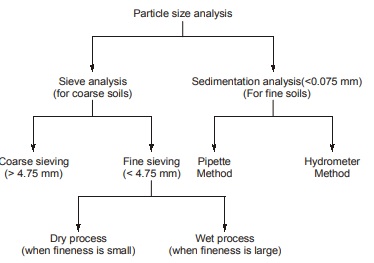
Sedimentation Analysis
- Sedimentation analysis or wet analysis is used to determine grain size distribution of the soil fraction passing through 75 µm size.
- It is based on the ‘Stoke’s Law’.
Stoke’s Law
If a spherical particle falls through infinitely large medium, then it will achieve a constant terminal velocity. Terminal velocity is given as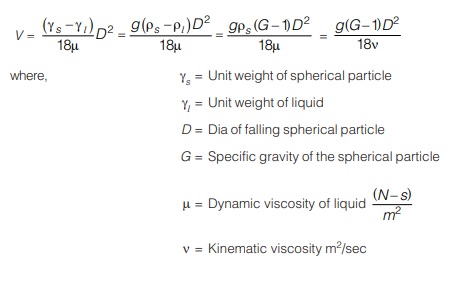
Limitations of Stokes Law
- The analysis is based on the assumption that the falling particle is spherical. But in soils, the finer particles are never truly spherical.
- Stoke’s law considers the velocity of free fall of a single sphere in a liquid of infinite extension, where as the grain size analysis is usually carried out in a glass jar in which the extent of liquid is limited.
- The fine grains of soil carry charges on their surface and have a tendency for floc formation. If the tendency of floc formation is not prevented, the diameter measured will be the diameter of the floc and not of the individual.

